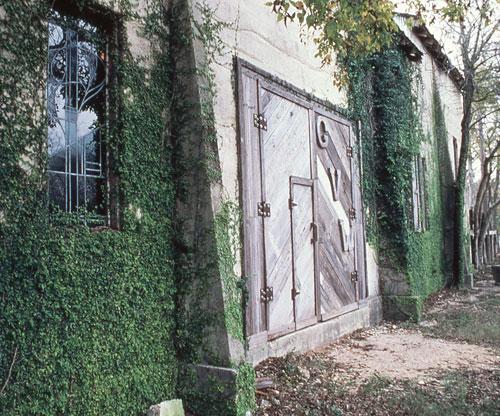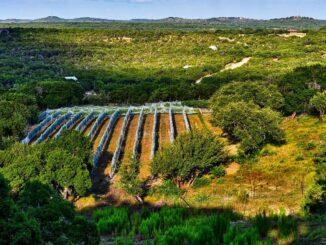
The problem with the restart to commercial wineries in Texas in the mid-1970s was the lack of wine-knowledgeablepeople here in Texas to accurately report on it.
David Frink, staff writer for the Austin American-Statesman was given the assignment and his story on the newly opened Guadalupe Valley Winery (GVW) ran on Sunday, July 17, 1977. He described the air around Bill Galagher’s warehouse in Gruene as having an “acrid bouquet”. As I read that and it conjured up thoughts of an irritatingly strong and unpleasant smell. Luckily, he later reported that the smell came from residual wine left in barrels outside that had turned to vinegar and not the finished wine itself as the initiator of this unpleasant odor. The bottom line though, it was not a flattering way to start a story about the new Guadalupe Valley Winery in Gruene, Texas.
One thing that Frink’s story gets right is the adversity that had to be overcome to bring back Texas as a wine producing region that at one time was purported to have produced two-thirds of the known American grapes in pre-prohibition times. Furthermore, at the time, 40-plus years of inattention to grape growing and winemaking in Texas made the comeback of the Texas wine industry difficult. It was subject to the perils of disease, wild invasive grasses and vermin of all sorts (with birds and raccoons on top of the list). The one thing that was not mentioned in this story was the similarity of the hill country’s marvelous limestone-rich soils to those in the vineyards of France and much of Europe. In the late 1800s, this attribute brought fame and much acclaim to Denison-Texas-based horticulturalist T.V. Munson who found our state’s wild grapes growing to make the perfect rootstock to bring back European vineyards after the scourge of Phylloxera. Only a few decades after this story, these same soils would grow quality wine grapes in the Texas Hill Country.

One of the issues noted in this story was the difficulty Texas wineries had getting Texas-grown grapes. In fact, Frink quotes Gallagher – Owner of GVW – as saying, “We’re not in the grape growing business. We’re in the winemaking business. We want Texas grapes and will contract with anyone who grows them.” Once I read this, I recalled one of the truisms that I’ve many in the Texas wine business talk about. That is… “It’s much easier to start a winery than to start a vineyard.” Gallagher apparently chose the easier road in this venture and left the hard work to others.
Frinks story indicated that Gallagher produced wine for his “Scharaffenland” label made from grapes picked from vineyards in Texas and other American locations, as well as using “unfinished” California wines. These included white, red and rosé wines with Frink offering Gallagher’s assessment of his own wines, saying “All three are ‘gulping and pleasant’, not the sipping variety.” OK, I’m not quite sure this is a rave review or a quote an experienced wine writer would have necessarily included in his story.
After this story, there is a journalistic “black hole” for GVW until 1984 when University of Houston-turned-author Frank Giordano wrote what was likely the first book dedicated to Texas wines and wineries of the time – all 15 of them. It was appropriately enough titled, “Texas Wines & Wineries”. In it, he tells the story of Larry and Donna Lehr. Evidently, Donna began working at the “Schlaraffenland” winery back during Gallagher’s days, and later Gallagher and his investors decided the wine business wasn’t for them. The winery manager Dean Valentine with financial assistance from the Lehr family purchased and together they operated the winery. The team of Larry, Donna and Dean jumped in to re-envision the winery with plans for growth and success.

According to Giordano, the new management team’s plans were to transition away from using primarily hybrid grapes like Black Spanish (Lenoir), Herbemont, and Carman) and venture into using Texas-grown vinifera grapes – the accepted wine grapes of Europe. Devoid of an estate vineyard or support yet from local farmers to grow these grapes, the Lehr’s purchased Ruby Cabernet and Zinfandel grapes from the University of Texas experimental vineyards in west Texas and had their initial vinifera wine release in 1983.
The management team at GVW also opened a restaurant in an old cotton gin on the property. The combination of the winery and restaurant along with Guerne being a well-traveled tourist destination worked out well. The mission of this new venture quickly became one of making wines, encouraging farmers to plant quality wine grapes, educating the public about wine, and running a restaurant that showed visitors how wine and food could be brought together for their ultimate enjoyment. However, the remaining question is… “What happened to Guadalupe Valley Winery?”
In 1989, according to the San Angelo Standard-Times, GVW was one of 10 Texas wineries featured by the Texas Department of Agriculture (including one mystery winery by the name of Bieganowski Cellars in El Paso). IN 1993, according to newspaper events listings from as far away as Galveston, GVW hosted live entertainment, arts and crafts showings, farmers markets, and antique fairs and offered music and dancing in Texas’s oldest dance hall nearby. It was listed as one of a growing number of new Texas wineries as late as 1995. Sadly, the final reference to GVW that I could find was in the Seguin Gazette-Enterprise dated June 1, 1997. It indicated that the old GVW winery building was going to be the site of a new silversmith studio.
While I was doing research and writing my second Texas wine book titled “Texas Hill Country Wineries” published by Arcadia Publications, I came across the photo archive of Ben Smuz, photographer for Frank Giordano, author of “Texas Wine & Wineries”. The color photos in this blog post were provided by Ben. The black and white photo is what ran with David Frink’s newspaper story. Evidently, pictures of this winery and its owner-operators are in short supply.
If you know anything further about Guadalupe Valley Winery and the situation leading to its closing, please post a comment or send me an email to VinetageTexas.com.



Be the first to comment